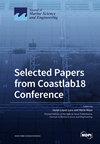Metachromadora parobscura sp. nov. and Molgolaimus longicaudatus sp. nov. (Nematoda, Desmodoridae) fromMangrove Wetlands of China
IF 2.8
3区 地球科学
Q1 ENGINEERING, MARINE
引用次数: 0
Abstract
Two new species of free-living marine nematodes, Metachromadora parobscura sp. nov. and Molgolaimus longicaudatus sp. nov., from mangrove wetlands of Beihai, Guangxi province in China, are described. Metachromadora parobscura sp. nov. is characterized by eight longitudinal rows of somatic setae arranged from the posterior part of the body, loop-shaped amphidial foveae with an open top and double contours, pharynx with bipartite cuticularized internal cavity, spicules with well-developed capitulum, gubernaculum canoe-shaped, without apophysis, 6–8 precloacal tubular supplements, and a short, conical tail with two ventral protuberances. It could be easily distinguished from the known species by spicule length and numbers of precloacal supplements. Molgolaimus longicaudatus sp. nov. is characterized by short cephalic setae, relatively small amphidial fovea, slender spicules ventrally bent with pronounced hooked capitulum and tapered distal end, two poriform precloacal supplements, and a relatively long conico-cylindrical tail. It differs from other species by the shape of spicules and long tail. Nearly full-length SSU sequences (1542–1592 bp) of the two species were provided, and phylogenetic trees based on maximum likelihood analyses supported the taxonomic position of the two new species. The combined use of traditional morphology-based taxonomy and molecular approaches has been proven to be a good choice for identification of free-living nematodes.Metachromadora parobscura sp.
描述了产自中国广西北海红树林湿地的两种自由生活的海洋线虫--Metachromadora parobscura sp.Metachromadora parobscura sp.nov.的特征是:体表刚毛从身体后部开始纵向排列成八排;两鳃窝呈环形,顶部敞开,具有双轮廓;咽部内腔具有两部分角质化;棘刺具有发达的头状突;鳃囊呈独木舟状,无骨干;前叶管状补充物有6-8个;尾部短而呈圆锥形,具有两个腹侧突起。它可以很容易地从孢子囊长度和前叶管补体数量上与已知物种区分开来。Molgolaimus longicaudatus sp. nov.的特征是头刚毛短、两鳃窝相对较小、细长的脊柱腹侧弯曲,具有明显的钩状头状突和锥形的远端、两个多孔状的前叶补足体和相对较长的圆锥形圆柱尾。它与其他物种的不同之处在于螺柱的形状和长尾。研究提供了这两个物种的近全长 SSU 序列(1542-1592 bp),基于最大似然法分析的系统发生树支持这两个新物种的分类位置。事实证明,结合使用传统的基于形态学的分类方法和分子方法是鉴定自由生活线虫的良好选择。
本文章由计算机程序翻译,如有差异,请以英文原文为准。
求助全文
约1分钟内获得全文
求助全文
来源期刊

Journal of Marine Science and Engineering
Engineering-Ocean Engineering
CiteScore
4.40
自引率
20.70%
发文量
1640
审稿时长
18.09 days
期刊介绍:
Journal of Marine Science and Engineering (JMSE; ISSN 2077-1312) is an international, peer-reviewed open access journal which provides an advanced forum for studies related to marine science and engineering. It publishes reviews, research papers and communications. Our aim is to encourage scientists to publish their experimental and theoretical results in as much detail as possible. There is no restriction on the length of the papers. The full experimental details must be provided so that the results can be reproduced. Electronic files and software regarding the full details of the calculation or experimental procedure, if unable to be published in a normal way, can be deposited as supplementary electronic material.
 求助内容:
求助内容: 应助结果提醒方式:
应助结果提醒方式:


